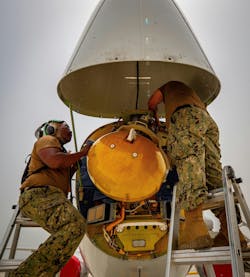Raytheon to prepare building seven AN/APY-10 airborne radar systems for P-8A Poseidon maritime surveillance
PATUXENT RIVER NAS, Md. – Maritime surveillance experts at RTX Corp. are preparing to build seven advanced airborne radar systems for the U.S. Navy Boeing P-8A Poseidon maritime patrol, surveillance, and anti-submarine warfare aircraft under terms of a $15.8 million order announced on Monday.
Officials of the Naval Air Systems Command at Patuxent River Naval Air Station, Md., are asking the RTX Raytheon segment in McKinney, Texas, to buy materials for building seven AN/APY-10 radar systems for the Navy, and AN/APY-10 spare parts for Canada and Germany.
The Raytheon AN/APY-10 maritime, littoral, and overland surveillance radar is a relatively new design for the P-8A. Compared with the previous-generation AN/APS-137 radar, the AN/APY-10 has reduced size, weight, and power (SWaP); additional target track capabilities, a new color weather avoidance mode, and room for technology growth, Raytheon officials say.
High-resolution radar
The P-8A Poseidon is a specially hardened and reinforced version of the Boeing 737-800 passenger jet, and is designed to operate either at extremely low altitudes or at high altitudes over the ocean to search for potentially hostile submarines. The P-8A is designed to withstand the rigors of low-altitude turbulence and exposure to salt spray.
The AN/APY-10 is integrated into the Boeing mission control and display system aboard the Poseidon for control, display, and data distribution. The airborne radar also will provide ultra-high-resolution imaging modes for maritime and overland operations. The radar fits in the nose of the Poseidon.
The Poseidon is replacing the P-3 Orion for long-range maritime patrol and anti-submarine warfare. The aircraft is equipped with modern avionics, anti-ship missiles, sophisticated torpedoes, sonobuoys, radar, and signals-intelligence gear. The Navy plans to buy 117 P-8As to replace its P-3 fleet.
On this order Raytheon will do the work in McKinney, Texas, and should be finished by March 2028. For more information contact RTX Raytheon online at www.rtx.com/raytheon, or Naval Air Systems Command at www.navair.navy.mil.
About the Author
John Keller
Editor-in-Chief
John Keller is the Editor-in-Chief, Military & Aerospace Electronics Magazine--provides extensive coverage and analysis of enabling electronics and optoelectronic technologies in military, space and commercial aviation applications. John has been a member of the Military & Aerospace Electronics staff since 1989 and chief editor since 1995.
